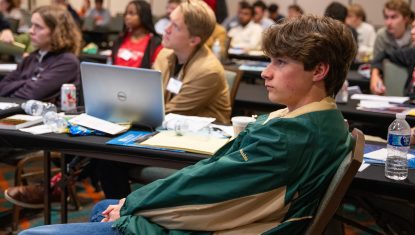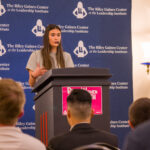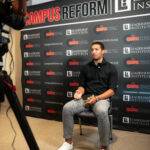What I am about to share with you is probably the most important lesson you will learn at any time in your life about success in the public policy process. Conservatives did not understand the real nature of politics for many years and certainly did not begin to teach it systematically until the early 1970s. Many conservatives today haven’t learned it yet.
Please bear with me as I begin with the important historical background. I’ll get to the key concepts soon enough.
What was the greatest difference between conservatives who supported Barry Goldwater in 1964 and those who supported Ronald Reagan in 1980? Most people don’t know the answer. The majority today aren’t old enough to remember the 1964 presidential campaign, but Barry Goldwater’s book, The Conscience of a Conservative, is still available and widely read. Fortunately, most people still remember Ronald Reagan and his conservative principles.
Anyone who supported Goldwater in 1964 and Reagan in 1980 can tell you that there was no significant difference in philosophy between Barry Goldwater and Ronald Reagan. You can see this for yourself. If you read The Conscience of a Conservative, published in 1960, you will see that Barry Goldwater’s positions on public policy issues then were very close to those of Ronald Reagan in 1980.
I can tell you from my personal experiences in the 1964 Goldwater campaign and in the 1980 Reagan campaign that there was one great difference between the approach to politics of the Goldwater supporters and the Reagan supporters 16 years later.
The difference was that we Goldwater supporters tended to believe that being right, in the sense of being correct, was sufficient to win. We firmly believed that if we could prove we were right, if we could logically demonstrate that our candidate was of higher character and that his policies would be better for our country, somehow victory would fall to our deserving hands like a ripe fruit off of a tree.
That’s not the real nature of politics. I call that misconception the Sir Galahad theory: “I will win because my heart is pure.”
Do you know what was the most used slogan of the Goldwater campaign? It was this: “In your heart, you know he’s right.”
Unfortunately the real world doesn’t work that way, as we who supported Goldwater found out when Lyndon Johnson trounced us. Johnson got 41 million votes and Goldwater got 27 million votes. To this day I’m convinced Barry Goldwater would have been a better President for the United States than Lyndon Johnson, but Lyndon Johnson won big.
Some Goldwater conservatives were so shocked and disappointed that they dropped out of politics and were never seen again. But not all of the Goldwater people left. Many of us stayed involved. Lots of us travelled similar paths and wound up working together.
In 1964, I had served as the youngest elected Goldwater Delegate to the Republican National Convention. The next year, 1965, I came to Washington to be executive director of the national College Republicans. Others with solid Goldwater pedigrees moved into the national scene at about the same time.
A young Goldwater supporter named Richard Viguerie came to Washington in 1965 and created his direct mail firm. He soon became the nationally dominant consultant in political direct mail and is still a leader in that field today.
Another notable young conservative, Ed Feulner, also came to Washington in 1965, to work for a think tank. Then he became a leading conservative congressional staffer. Now he is president of the massive and effective Heritage Foundation.
Another young Goldwater supporter, Paul Weyrich, came to Washington the next year, in 1966, to serve as press secretary for a conservative U.S. Senator from Colorado. Weyrich soon became the key conservative expert on politics on Capitol Hill. He later became America’s most successful organizer of conservative organizations and institutions, playing a key role for more than 40 years in founding important new groups.
All of us had supported Goldwater, but none of us was prominent in his campaign. In fact, none us even knew each other until we got to the D.C. area and began to build our own national reputations as fighters in different ways for conservative principles. But in those days, our past support of the Goldwater campaign was a priceless credential among fellow conservatives.
Lee Edwards, a friend of mine who served as Director of Information in the 1964 Goldwater campaign had founded in 1965 what was probably the D.C. area’s only conservative public relations firm. Now Dr. Edwards, he has become the nation’s foremost historian and biographer of the conservative movement. In May 1972, Edwards introduced me to Richard Viguerie.
A week later Viguerie hired me away from the conservative think tank where I then worked in D.C. He said, “Morton, I want you to come help me build a conservative movement.”
Richard Viguerie meant what he said, and his words were music to my ears because building a conservative movement was exactly what I wanted to do. Soon, with my help as his political assistant, Richard began to gather frequently a small group of experienced, totally reliable conservatives who were serious about trying to figure out how to win for conservative principles.
Included in our meetings were those I have named, including Lee Edwards, and others whom we believed shared our conservative principles and our determination eventually to win for those principles in government, politics, and the news media. We were tired of losing.
We discussed what had worked well for the political left, why conservatives had lost so many political battles, and what conservatives might do to win in the future.
It came down to this: What is the real nature of politics?
Here was our first great conclusion: Being right in the sense of being correct is not sufficient to win. You don’t win just because your heart is pure, even if you can prove logically that you are right.
What, then, does determine victory?
In our frequent meetings and discussions, we came to our second great conclusion: The winner in a political contest over time is determined by the number and the effectiveness of the activists and leaders on the respective sides.
That fundamental understanding changed our thinking. It explains why the side that’s right doesn’t necessarily win.
Next we considered the vital question of what determines the number and effectiveness of the activists and leaders on a given side. Clearly, numbers and effectiveness do not depend on which side is right.
Our third great conclusion was: The number and effectiveness of the activists and leaders on a given side in a political contest is determined by the political technology used by that side.
That explains a lot of political history, including why bad causes, like communism, attracted a lot of activists. The people on the political left used effective political technology. In contrast, most conservatives had relied on proving we are right.
Political technology can be roughly divided into communication technology and organization technology, with no neat line of separation between communication and organization.
Most political technology is philosophically neutral. Techniques which work for the left can work for conservatives. Techniques which work for Republicans can work for Democrats, and vice versa. Similar techniques can work whether a public policy battle is an election or a legislative battle over tax rates, the right to keep and bear arms, abortion, or any other issue.
In the 1970s, when we made what were for us these discoveries about the real nature of politics, we saw this new understanding as a terrific insight which could lead to victory for conservative principles in the public policy process of government, politics, and the news media.
But because most political technology is philosophically neutral, most people who are deeply committed philosophically tend to disdain to study or use political technology. Instinctively, people devoted to their political principles tend to think learning mere skills is beneath their dignity because techniques are philosophically neutral.
Such people are, after all, thinking about and proving their wonderful, deeply held views on important public policy questions.
Is abortion the murder of tiny babies? What must be done to stop the spread of worldwide communism? What must be done to keep big government from destroying economic liberty and prosperity?
“They will take my gun only by prying it from my cold dead fingers. God made man, but Winchester made men equal!”
Serious questions. Serious people can get very excited about issues and philosophic differences, but they instinctively tend to think poorly of the study or practice of philosophically neutral skills.
Political technology is composed of a universe of specific techniques. Of course, not all political techniques are philosophically neutral. Terror is an evil technique used most commonly by the left. Communists famously and effectively use terror to grab power and keep it. But most political technology has no inherent philosophical content.
How you design a piece of political literature, how you raise funds, how you organize a precinct, how you attract a crowd to a political event, how you communicate to a mass audience online — those techniques can work for anybody.
You may wonder now what I mean by techniques. Most of the most useful techniques don’t involve complex computer programming.
Let me use, for example, the techniques available for something as simple as a nametag.
How often have you seen pre-printed nametags which begin, in big letters, with “HELLO, MY NAME IS”? That’s a bad technique. The printed message is useless, and it takes space on the nametag which could be used for communication.
How many times have you attended meetings where someone has thoughtfully printed nametags for everyone in advance, in letters about the size a typewriter would produce? That’s a bad technique because it wastes space which be used for communication.
How many times have you had to write your name on a nametag with a thin-line ballpoint pen? That’s a bad technique because a name written by a wide-line, felt-tip pen is easier to read.
Often people print or write names on nametags in all capital letters. That’s a bad technique because capitalizing only the first letters makes the nametag easier to read. The name on a nametag should comfortably fill the entire space available.
Where do you place a nametag? Most people instinctively place their nametags on their left shoulders. Wrong. The best place for your nametag is on your right shoulder, where people can most easily read it when you extend your right hand to greet them.
Thousands of known techniques work. Very few techniques in politics are as complex as rocket science. Most are as simple as learning the types of print font which are easiest to read or what I have said about nametags.
The right techniques can make you more effective in everything you work to achieve. Each good technique you use in politics makes it more likely that you will win.
But many philosophically committed conservatives tend to believe that being right, in the sense of being correct, is sufficient to win.
Those of us who began to meet in 1972 discovered the real nature of politics:
- The winner in a political contest over time is determined by the number and the effectiveness of the activists and leaders on the respective sides, and
- The number and the effectiveness of the activists and leaders on a given side is determined by the political technology that side employs.
We knew that many of our conservative allies thought otherwise and that we would have to persuade them differently.
Here is how we convinced many of them. We shared with them our analysis of the real nature of politics, and then said, “If that is true, you owe it to your philosophy to study how to win. You owe it to your philosophy to study how to win. You have a moral obligation to learn how to win.”
If you allow your opposition to learn better how to organize and communicate than you do and they implement that technology, they will beat you no matter how right you are — and you don’t deserve to win.
That is a persuasive argument. When you talk in terms of a moral obligation, you’re talking in terms people can understand if they have a strong philosophical commitment.
We began to have success teaching committed conservatives this, the real nature of politics, and it had a remarkable and sudden impact.
New groups began to spring up in a wide range of issue areas. A wide variety of specialized organizations: educational foundations, legal defense foundations, lobbying organizations, and political action committees.
Conservatives began to study how to win. Existing conservative organizations also began to grow very rapidly. For example, in 1972, one of the biggest, most effective, most famous, most respected and even most feared organizations on the conservative side was the National Right to Work Committee.
In 1972 they had 25,000 members, and they were thought of as really big stuff. Then they began to study and use communication and organization technology. They began to grow throughout the 1970s, from 25,000 members in 1972 to 1.7 million National Right to Work Committee members in 1979. Then they really were big and could affect policy in a major way.
At first a handful of new conservative groups started. Then dozens. Then conservatives started hundreds of new national and local groups. Each new or newly large group contributed an increase in the number and the effectiveness of conservative activists and leaders.
By 1980 conservatives had the political muscle across the country not only to nominate Ronald Reagan for President but to elect him.
That wasn’t the first time Reagan had run for President. I was a Reagan alternate Delegate in the presidential campaign of 1968, when he made his first, brief run for President. Again I was a Reagan alternate Delegate in 1976, when he ran against President Ford for the nomination and almost won.
By 1980 the conservative movement had grown remarkably. Reagan won nomination convincingly and then won election. And I got to serve three years on the Reagan White House Staff.
All of this is of central importance for you because the potential for growth of conservative political strength still exists. The rapid, spontaneous growth of grassroots conservative activity in 2009 and 2010 proves that.
It turns out that the more groups you have and the greater the number of people you activate and teach how to be effective, the more power that you have to impact on the public policy process.
I don’t have to tell you how often Supreme Court decisions on leftist versus conservative issues are now decided on a five to four basis. The next Congress is likely to be closely divided between conservatives and the left, with many congressional elections decided by only a handful of votes.
The next presidential election is likely to be very close. Conservatives may once again be able to unite behind a conservative to win a presidential nomination and the 2012 presidential election.
The margins of victory in the American public policy process may be smaller now than at any other time in American history. You can make a difference, now and in the future.
The number of American conservative activists and leaders is certainly growing. To grow in effectiveness, they must study how to win.
My Leadership Institute now offers 40 types of training schools in the public policy process. You can review those 40 types of schools at leadershipinstitute.org. For the first time, political training for conservatives is available online, on demand, and free 24 hours a day.
Other conservative organizations also offer worthwhile training you should consider.
Nothing would be more disappointing politically than for conservatives to lose because of avoidable mistakes.
So I urge you, remember the real nature of politics and the clinching argument which has revived the power of conservative principles in America: You owe it to your philosophy to study how to win. You have a moral obligation to learn how to win.










